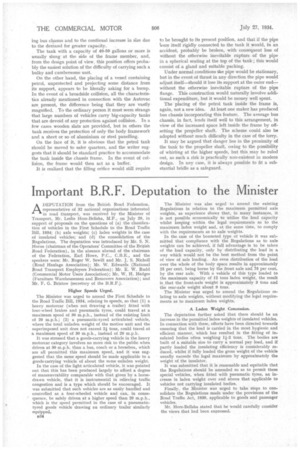Important B.R.F. Deputation to the Minister A DEPUTATION from the British
Page 52

If you've noticed an error in this article please click here to report it so we can fix it.
Road Federation, representative of 32 national organizations interested in road transport, was received by the Minister of Transport, Mr. Leslie Hore-Belisha, M.P., on July 20, in support of proposals on the questions of (a) the classification of vehicles in the First Schedule to the Road Traffic Bill, 1934; (b) axle weights; (c) laden weights in the case of insulated vehicles; and (d) the consolidation of the Regulations. The deputation was introduced by Mr. S. N. Home (chairman of the Operators' Committee of the British Road Federation), in the absence abroad of the chairman of the Federation, Earl Howe, P.C., C.B.E., and the speakers were: Mr. Roger W. Sewill and Mr. J. S. Nicholl (Road Haulage Association); Mr. W. Edwards (National Road Transport Employers Federation); Mr. E. W. Rudd (Commercial Motor Users Association); Mr. W. H. Hedges (Furniture Warehousemen and Removers Association); and Mr. F. G. Bristow (secretary of the B.R.F.).
Higher Speeds Urged.
The Minister was urged to amend the First Schedule to the Road Traffic Bill, 1934, relating to speeds, so that (1) a heavy motorcar (when not drawing a trailer) fitted with four-wheel brakes and pneumatic tyres, could travel at a maximum speed of 30 m.p.h., instead of the existing limit of 20 m.p.h.; (2) a pneumatic-tyrecl articulated vehicle, where the total unladen weight of the motive unit and the superimposed unit does not exceed 2i tons, could travel at a maximum speed of 30 m.p.h., instead of 20 m.p.h.
It was stressed that a goods-carrying vehicle in the heavy motorcar category involves no more risk to the public when driven at 30 m.p.h. than a bus, coach or a horsebox, which are all permitted this maximum speed, and it was suggested that the same speed should be made applicable to a goods-carrying vehicle of about the same unladen weight.
In the case of the light articulated vehicle, it was pointed out that this has been produced largely to afford a degree of manceuvrability comparable with that given by a horsedrawn vehicle, that it is instrumental in relieving traffic congestion and is a type which should be encouraged. It was submitted that such vehicles are as easily handled and controlled a.s a four-wheeled vehicle and can, in consequence, be safely driven at a higher speed than 20 m.p.h., which is the speed permitted in the case of a pneumatictyred goods vehicle drawing an ordinary trailer similarly equipped.
B34 The Minister was also urged to amend the existing Regulations in relation to the maximum permitted axle weights, as experience shows that, in many instances, it is not possible economically to utilize the load capacity whilst keeping within the legal requirements as to the maximum laden weight and, at the same time, to comply with the requirements as to axle weights.
In the case of the bonneted type of vehicle it was submitted that compliance with the Regulations as to axle weights can be achieved, if full advantage is to be taken of the load capacity, only by distributing the load in a way which would not be the best method from the point of view of safe loading. An even distribution of the load over the whole of the body space results in approximately 25 per cent, being borne by the front axle and 75 per cent. by the rear axle. With a vehicle of this type loaded to the maximum capacity of 12 tons laden weight, the result is that the front-axle weight is approximately 3 tons and the rear-axle weight about 9 tons.
The Minister was urged to amend the Regulations relating to axle weights, without modifying the legal requirements as to maximum laden weights.
A Laden Weight Concession.
The deputation further asked that there should he an increase in the permitted laden weights of insulated vehicles. In connection with these, efforts have been directed towards ensuring that the load is carried in the most hygienic and efficient manner, which has resulted in the fitting of insulated bodies often weighing 11-2 tons. The bodies are built of a suitable size to carry a normal pay load, and if partly loaded the insulating efficiency is considerably reduced, whilst if fully loaded the gross weight of the vehicle usually exceeds the legal maximum by approximately the weight of the insulator.
It was submitted that it is reasonable and equitable that the Regulations should be amended so as to permit these special vehicles, when fitted with pneumatic tyres, an increase in laden weight over and above that applicable to vehicles not carrying insulated bodies.
Finally, the Minister was urged to take steps to consolidate the Regulations made under the provisions of the Road Traffic Act, 1930, applicable to goods and passenger vehicles.
Mr. Hore-Belisha stated that he would carefully consider the views that had been expressed.




































































































